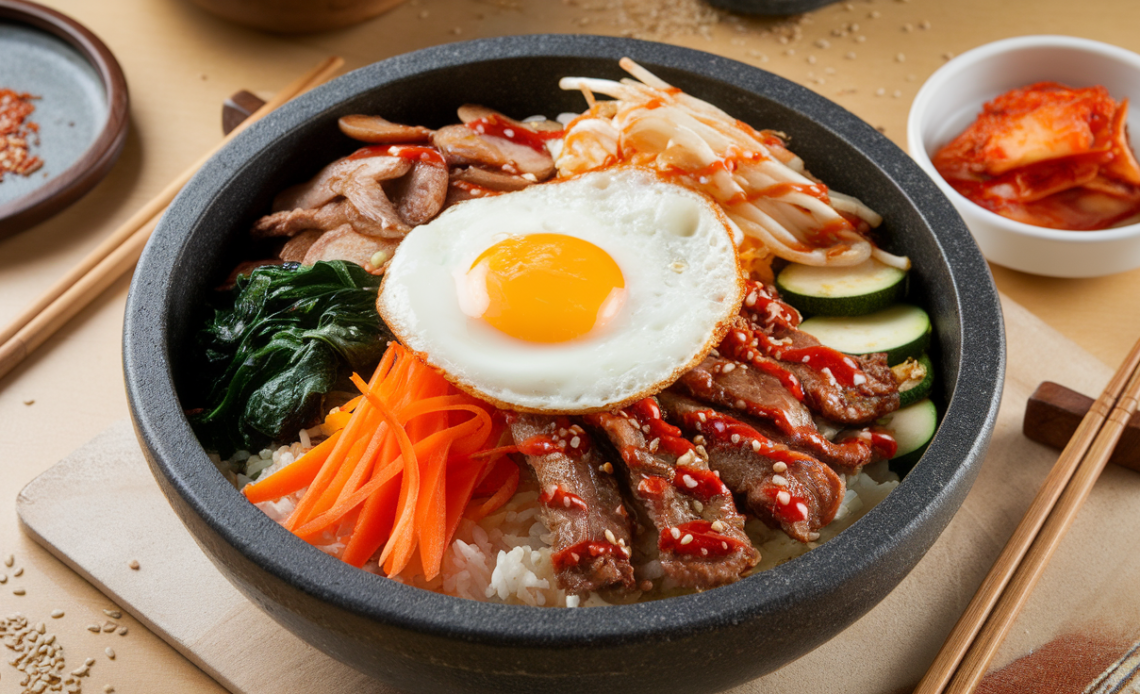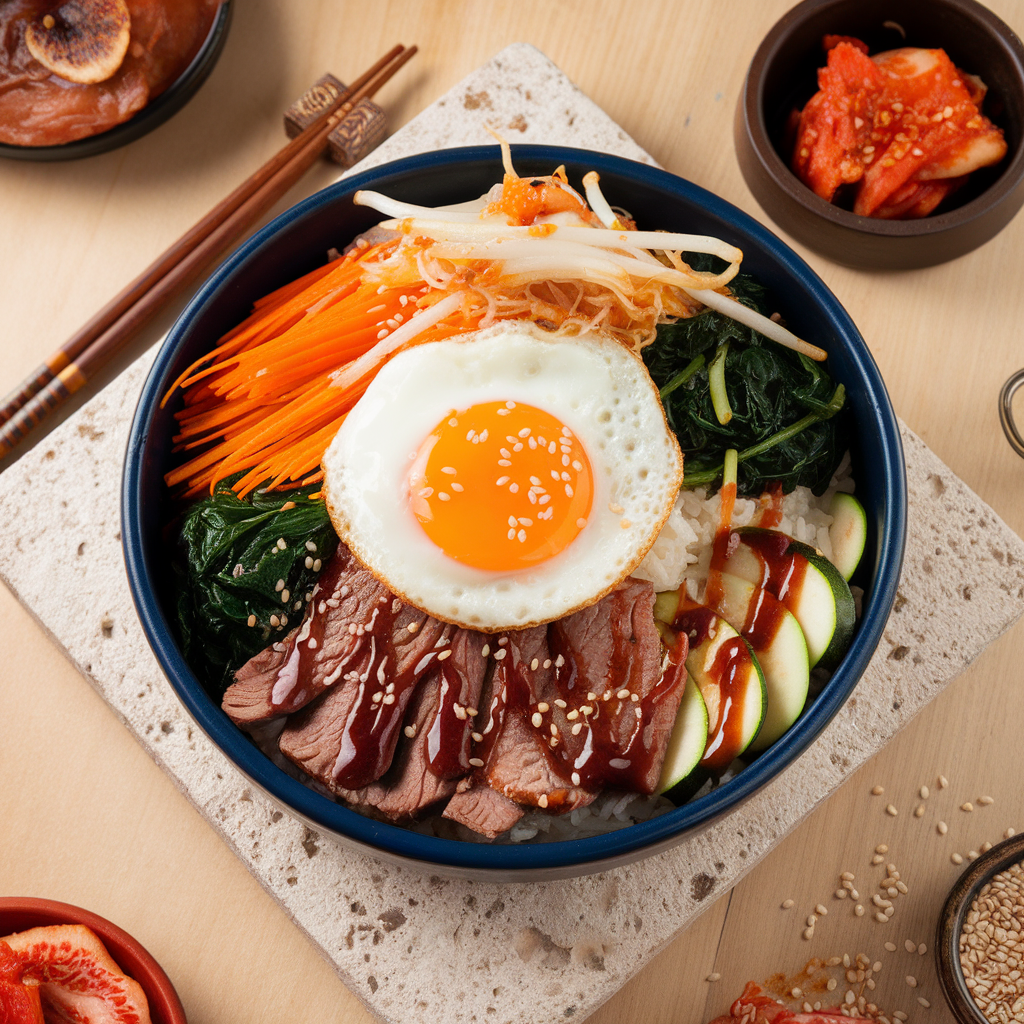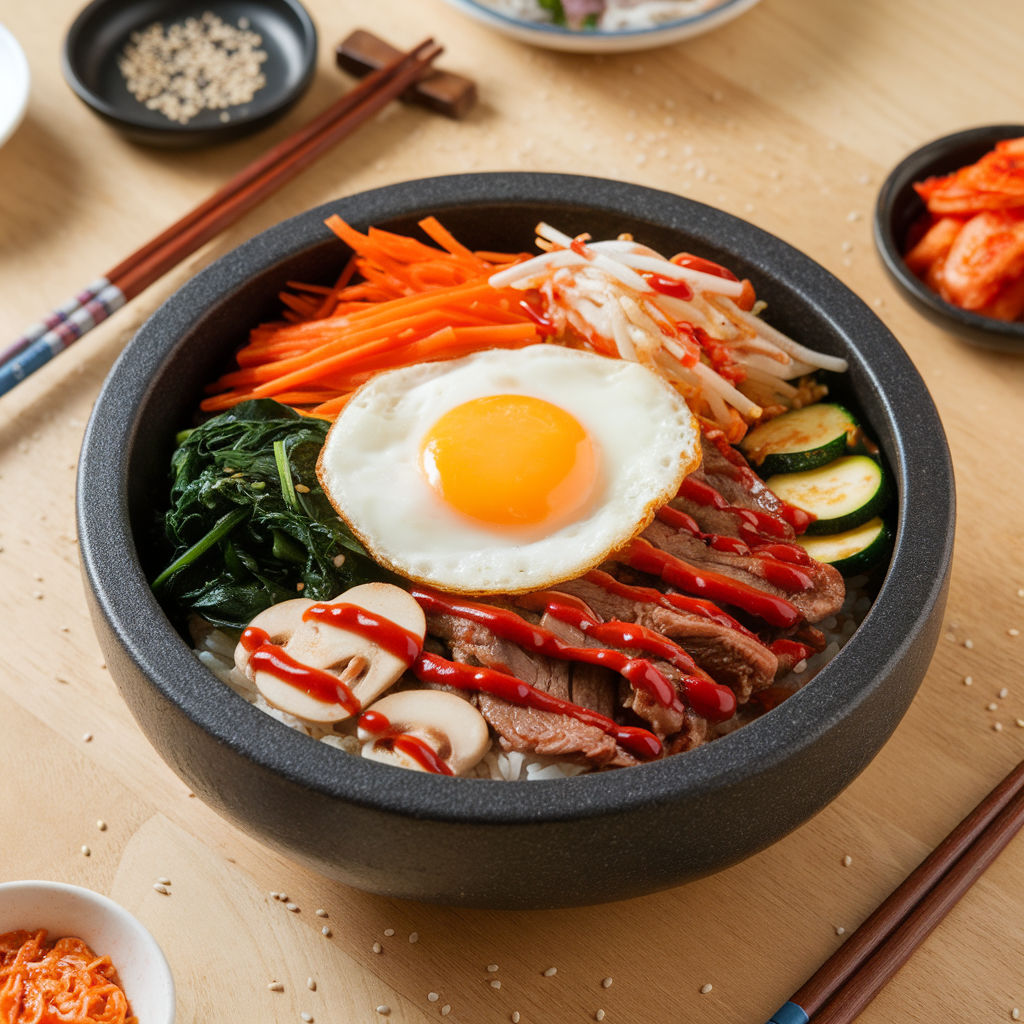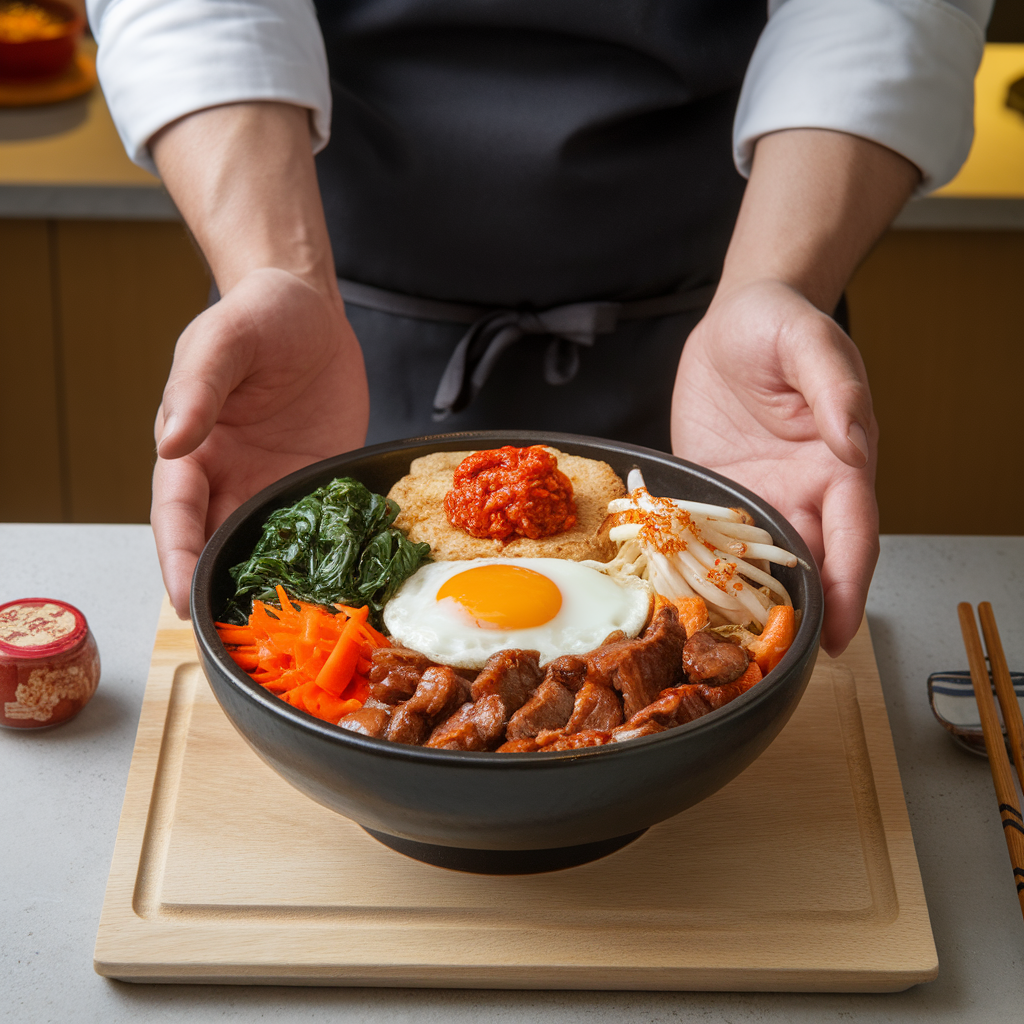
There’s something deeply satisfying about a dish that combines vibrant vegetables, savory meat, fluffy rice, and a spicy-sweet sauce into one harmonious bowl. That’s the essence of Bibimbap (비빔밥) — a beloved Korean classic known for its colorful presentation and nutritional balance. Whether you’re new to Korean cuisine or a seasoned fan, this Korean Bibimbap Recipe will become a staple in your kitchen.
What Is Bibimbap?
The word Bibimbap translates to “mixed rice,” and that’s essentially what it is: a bowl of warm rice topped with seasoned vegetables (namul), ground or sliced meat (traditionally beef), a fried or raw egg, and a generous dollop of gochujang (Korean red chili paste). Everything is stirred together right before eating, creating a flavorful medley in every bite.
This dish has deep roots in Korean culture and is often enjoyed during family gatherings, holidays, or even as a quick and healthy weeknight dinner. Variations include Ground Beef Bibimbap, vegetarian styles, and the sizzling hot stone version called Korean Dolsot Bibimbap, where the rice crisps at the bottom of the bowl.
Why You’ll Love This Korean Bibimbap
- Balanced and Nutritious: A complete meal in one bowl—carbs, protein, vegetables, and healthy fats.
- Customizable: Swap veggies, proteins, or even rice for what you have on hand.
- Meal Prep Friendly: Prep the toppings in advance and assemble when ready to eat.
- Bold Flavors: From the umami-rich beef to the spicy-sweet gochujang sauce, every bite is deliciously complex.
Ingredients for Korean Bibimbap Recipe
For the Base:
- 3 cups cooked short-grain rice (preferably jasmine or sticky white rice)
- 2 teaspoons sesame oil
For the Ground Beef (or protein of choice):
- 1 lb ground beef (or ground chicken, tofu for vegetarian version)
- 2 tablespoons soy sauce
- 1 tablespoon sesame oil
- 1 tablespoon brown sugar
- 2 garlic cloves, minced
- 1/2 teaspoon grated ginger
- 1/4 teaspoon black pepper
Vegetable Toppings:
- 1 cup bean sprouts (blanched)
- 1 cup julienned carrots (lightly sautéed)
- 1 cup zucchini, julienned (sautéed)
- 1 cup shiitake mushrooms or any mushrooms (sautéed)
- 1 cup spinach (blanched and seasoned with sesame oil + salt)
- Kimchi (optional but recommended for an extra Korean kick)

For the Sauce (Gochujang Bibimbap Sauce):
- 3 tablespoons gochujang (Korean red chili paste)
- 1 tablespoon sesame oil
- 1 tablespoon rice vinegar
- 1 tablespoon honey or brown sugar
- 1 teaspoon soy sauce
- 1 teaspoon water (to thin out if needed)
Toppings:
- 4 eggs (fried sunny side up)
- Toasted sesame seeds
- Sliced green onions
- Seaweed strips (optional)
How to Make Korean Bibimbap
Step 1: Cook the Rice
Start with warm, fluffy white rice. You can also use brown rice or cauliflower rice for a low-carb option. Drizzle with a bit of sesame oil to keep it from sticking and to add a nutty aroma.
Pro Tip: For Korean Dolsot Bibimbap, use a hot stone bowl to get that crispy rice crust at the bottom. Simply heat the bowl over medium heat, add sesame oil and rice, and let it sizzle for 3–5 minutes before assembling.
Step 2: Prepare the Beef
In a large skillet, cook the ground beef over medium heat. Once it starts to brown, add soy sauce, sesame oil, sugar, garlic, ginger, and black pepper. Stir well and cook until beef is caramelized and juicy.
This Ground Beef Bibimbap method is quicker than traditional sliced bulgogi and perfect for busy weeknights.
Step 3: Sauté or Blanch the Veggies
Each vegetable should be cooked individually to preserve its color and texture. Use a small amount of sesame oil or a neutral oil to sauté.
- Carrots: Cook for 2–3 minutes until slightly tender.
- Zucchini: Sauté until soft but not mushy.
- Mushrooms: Cook until browned and aromatic.
- Spinach: Blanch quickly and squeeze out excess water. Season with sesame oil and salt.
- Bean Sprouts: Blanch for 1–2 minutes, then season lightly.
These Korean Veggies add beautiful contrast and nutrients to your bibimbap bowl.
Step 4: Make the Gochujang Sauce
In a small bowl, whisk together gochujang, sesame oil, rice vinegar, honey, and soy sauce. Adjust spiciness to your preference by adding more or less gochujang.
Store extra sauce in the fridge for up to a week—it’s great on eggs, grilled meats, or even tacos.

Step 5: Fry the Eggs
Fry each egg sunny side up, so the yolk stays runny and rich. The yolk acts like a creamy sauce once mixed into the bowl.
Step 6: Assemble Your Korean Bibimbowl
In a wide bowl, layer the ingredients:
- Start with a scoop of rice at the bottom.
- Neatly arrange cooked vegetables, beef, and kimchi around the bowl.
- Place the fried egg in the center.
- Add a spoonful of gochujang sauce.
- Garnish with sesame seeds, green onions, and optional seaweed.
How to Eat Bibimbap (The Fun Part!)
Just before eating, mix everything thoroughly with a spoon so that the gochujang, egg yolk, and other elements coat the rice and veggies evenly. It’s messy, satisfying, and oh-so-delicious.
Tips for the Best Homemade Bibimbap
- Keep it Colorful: Use at least 4–5 types of vegetables for vibrant appeal.
- Use Fresh Ingredients: The flavors shine best when your vegetables are crisp and your meat is freshly cooked.
- Adjust to Taste: Add more soy sauce, spice, or even a squeeze of lime if you’re feeling creative.
- Add Crunch: A handful of toasted seaweed or even crispy onions can bring more texture.
Make It Your Own: Bibimbap Variations
1. Vegetarian or Vegan Bibimbap
Omit the beef and use marinated tofu or tempeh. Replace the egg with avocado slices or a vegan egg alternative.
2. Chicken or Seafood Bibimbap
Grilled chicken, spicy shrimp, or even salmon can replace beef. These options are lighter and just as flavorful.
3. Keto Bibimbap
Swap the rice for cauliflower rice and skip sugar in the sauce. Use high-fat toppings like a runny egg, avocado, and sesame oil.
4. Breakfast Bibimbap
Include breakfast favorites like scrambled eggs, bacon crumbles, and sautéed spinach with gochujang ketchup.
With Carlsbad Cravings and other modern food blogs inspiring Korean fusion dishes, the possibilities are endless!

Why Bibimbap Is More Than Just Food
Bibimbap is more than just a meal—it’s a celebration of balance and harmony. In Korean tradition, it’s often symbolic of togetherness, representing various components (like people) coming together to create something whole and beautiful.
This dish has also gained popularity worldwide thanks to Korean dramas, food bloggers, and the rise of K-culture. Whether you’re recreating the comfort of Seoul or simply looking to try something new, this Bibimbap Recipe brings bold flavors and a cultural experience to your table.
Storage and Meal Prep
Storage: Store each component separately in airtight containers for up to 4 days. Reheat the rice and protein before assembling.
Meal Prep Tip: Cook the vegetables and protein ahead of time. Prepare a large batch of sauce. When you’re ready to eat, just cook fresh rice and fry an egg.
Serving Suggestions
- Pair with Korean side dishes like kimchi, pickled radish (danmuji), or cucumber salad (oi muchim).
- Enjoy alongside a hot bowl of miso soup or seaweed soup.
- Add a cool drink like barley tea or Korean pear juice.
Final Thoughts
Bibimbap is proof that simplicity and sophistication can coexist in one bowl. With bold umami, satisfying texture, and fresh vegetables, this Korean classic is a go-to for both comfort and nutrition.
Whether you’re a fan of traditional Korean Dolsot Bibimbap, a hearty Ground Beef Bibimbowl, or a veggie-loaded version, this recipe lets you bring Korean soul food straight to your kitchen.




